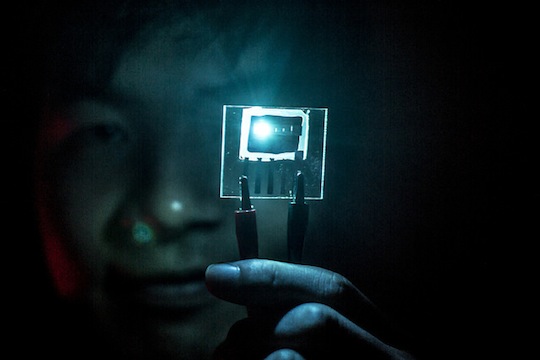This article is more than 1 year old
Boffins' better blues beat battery blues
Making displays more efficient
All the way from the battery in a pocket to the LED TV on a wall, the colour blue is a problem: blue LEDs are less efficient than the reds or greens that make up the other two primary display colours, and that's a problem for power consumption.
Researchers at the University of Michigan are now claiming as much as a fourfold improvement in blue OLED (organic LED) efficiency coupled with a tenfold improvement in lifetime.
As the university explains here, OLEDs are either fluorescent or phosphorescent – and the latter is far more efficient than the former. PHOLEDs, as the phosphorescent varieties are known, are used for red and green pixels, but not blue.
Engineering professor Stephen Forrest explains that while blue PHOLEDs have been around for a long time, they don't live long enough for use alongside reds and greens in consumer devices. That means fluorescent OLEDs are used for the blues, and that in turn imposes a power consumption penalty.
According to Forrest, the higher energy needed to produce light at the blue end of the spectrum (compared to red or green) is the problem his research team has been working on since 2008. That higher energy can break down the molecules in the OLEDs, when enough is poured in to get light sufficiently intense to use in a display.

University of Michigan's Jae Sang Lee with the Blue PHOLED
In a study lead-authored by Yifan Zhang with work from doctoral student Jae Sang Lee, the researchers worked to spread the light emitting energy across enough molecules to avoid individual molecules getting burned.
As the university's release explains: “If the light-emitting molecules are evenly distributed, the energetic electron-hole pairs tend to accumulate near the layer that conducts electrons, causing damaging energy transfers.
“Instead, the team arranged the molecules so that they were concentrated near the hole-conducting layer and sparser toward the electron conductor. This drew electrons further into the material, spreading out the energy.”
This insight, combined with splitting the blue PHOLED into two layers (to reduce the concentration of light-emitting molecules in each layer), yielded a tenfold improvement in device lifetime, the university claims.
The work will be published in an upcoming issue of Nature Communications. ®
